June 4, 2017
Martha O'Kennon
Another magnificent week for sleuthing around the yards. Many of the 'specially planted plants have given way to other more hardy ones. One of the plants I used to have crowding out other things is this gorgeous blue spiderwort. The bladder campion was getting trounced by the other weeds: maple seedlings, goldenrod, and the occasional poison ivy. But up against the shop wall it seems to do quite well, probably because my big rule #1 is: don't walk up close to the shop wall. Finally, a lone Stella d'Oro daylily has its first bloom.
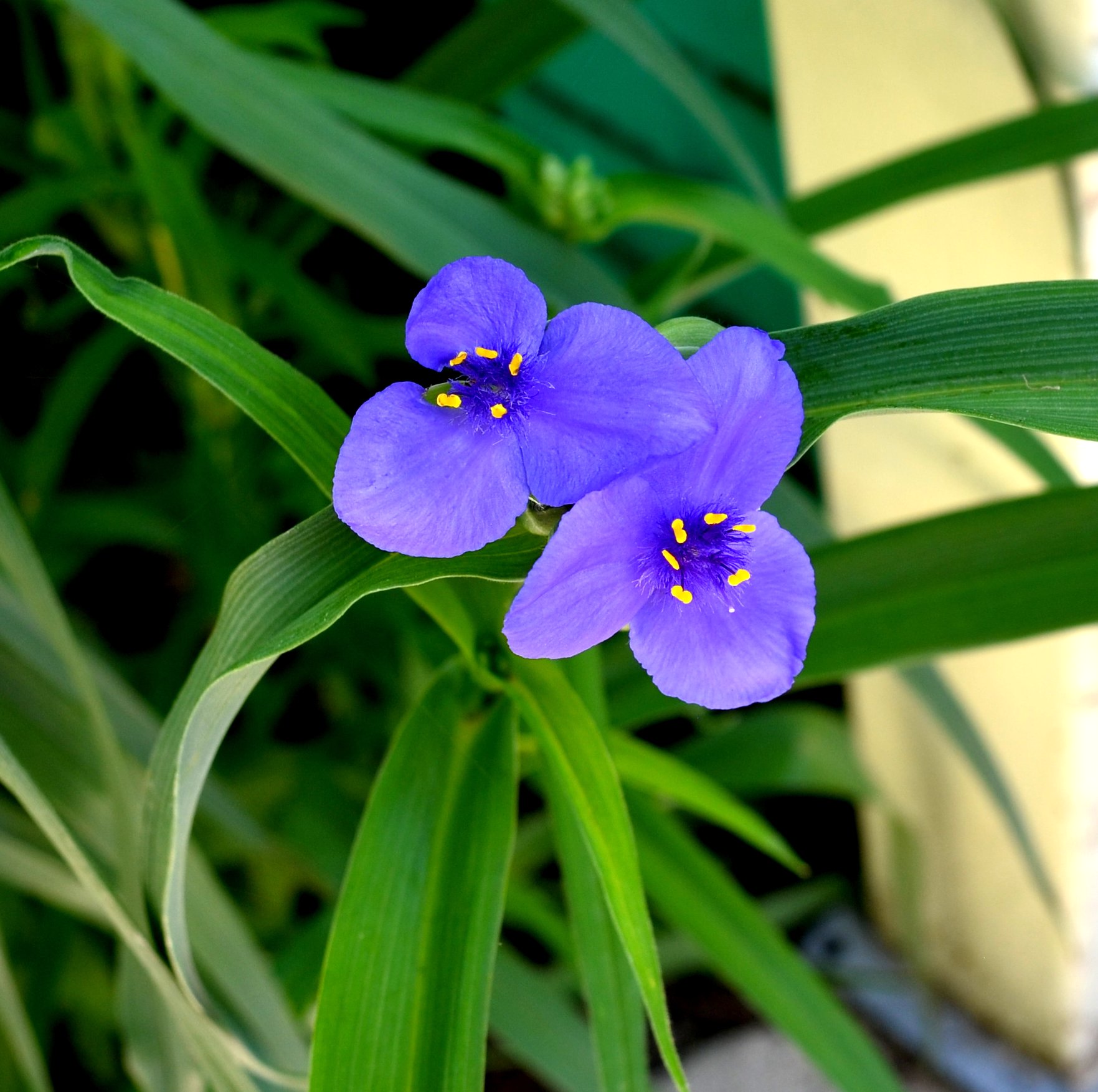
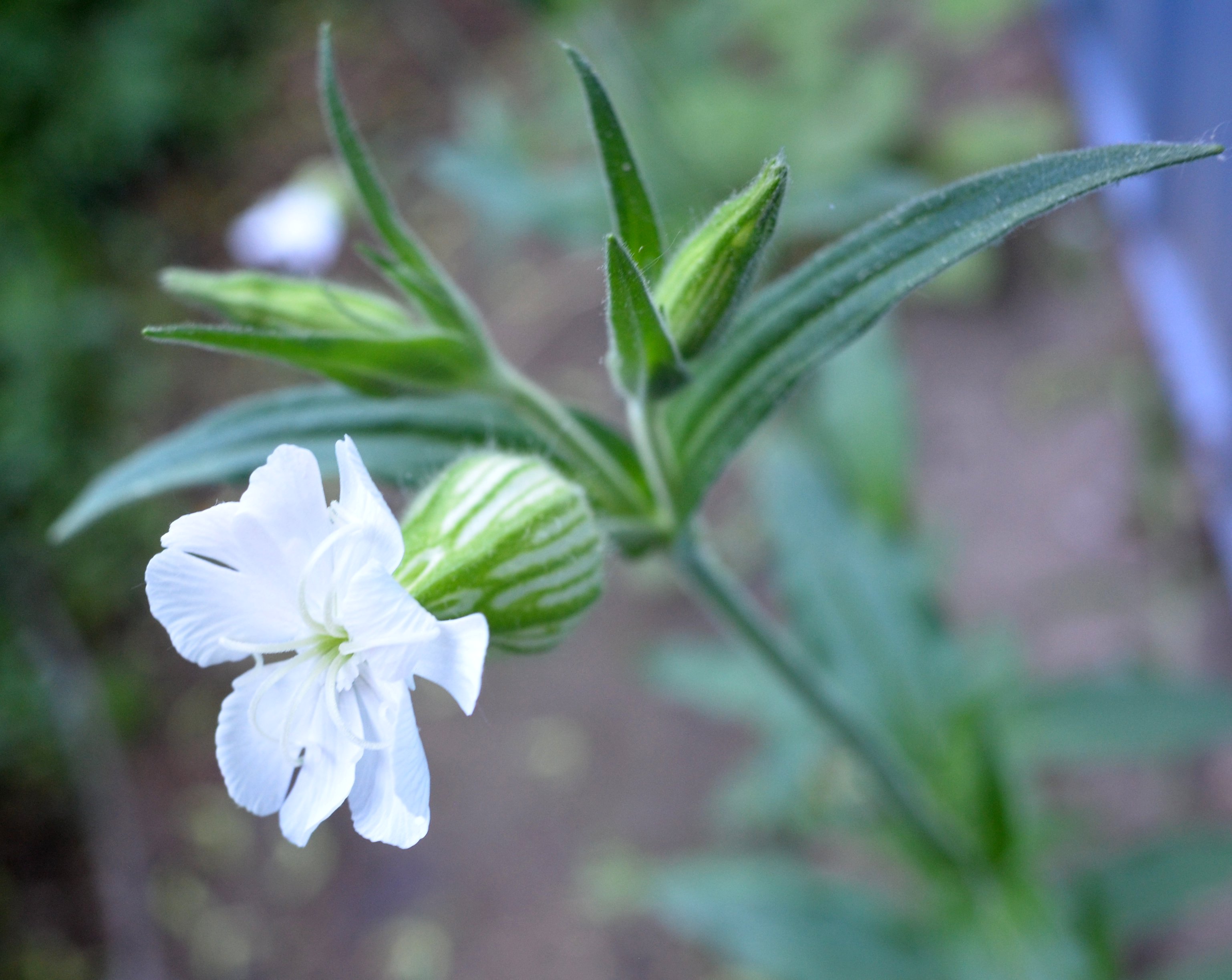

Remember that there is information in the name of the file for each image. You can see it by mousing over the image - look at the lower left of the screen.
Or you can click on the image to get to the (usually) larger image. Then the info is displayed in the address line above.
Ants are everywhere, including near the kitchen sink. But no super duper pictures, now that we're family. The barklouses have really moved in. Last week I had to take a picture of something so small as hardly to be seen as an insect at all! Now I can sometimes spot one by eye. That means getting close enough to "see" (perceive) a creature and not be perceived back! I wonder how the little personages do see us, very Swiftian! We still have the regulation grade honey bees, but now we also have many kinds I haven't yet found in my new bee book. Image #2 is now one of the big visitors, and image #3 another.

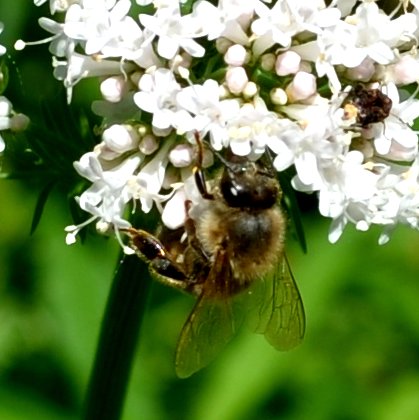
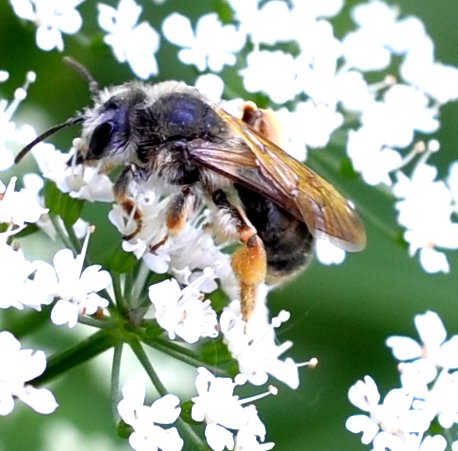
More on bees. I promise to do better up-looking so we can recognize them better. I can use this spot (right here) to tell you that no bee that has been seen in this week's blog has ever buzzed loudly or turned from a flower to chase onlookers. And never has stung the author in 4 years of photographing them. Sometimes I think I grew up with a certain amount of learned fear of all things hymenopteran. That can render the onlooker's eyes less geared to identification. If you're known to be sensitive to bee (or wasp)stings, get an epi-pen and learn how to use it just in case. But don't let old fears overwhelm the pleasure center that can greatly enhance the sight of these beautiful beasties. No more sermons.
So here are a few more bees. #1 is still unidentified, but looks to be built like a cargo plane. Number two - the Sweat Bees are back. They come in several sizes but this is at least a medium-sized one. What a green! Number three is the Nomad Bee I was telling you about last week. Not long after I'd said I hadn't seen one yet this year, there it was. It tends to flit about, and this is the only one of a long string of shots that was still enough to more or less capture. Don't you love that purple?
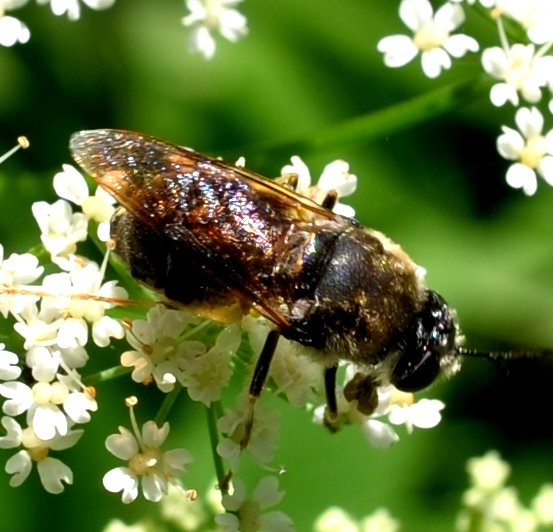
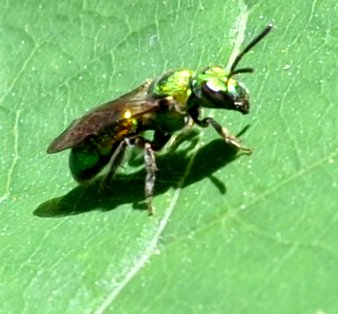
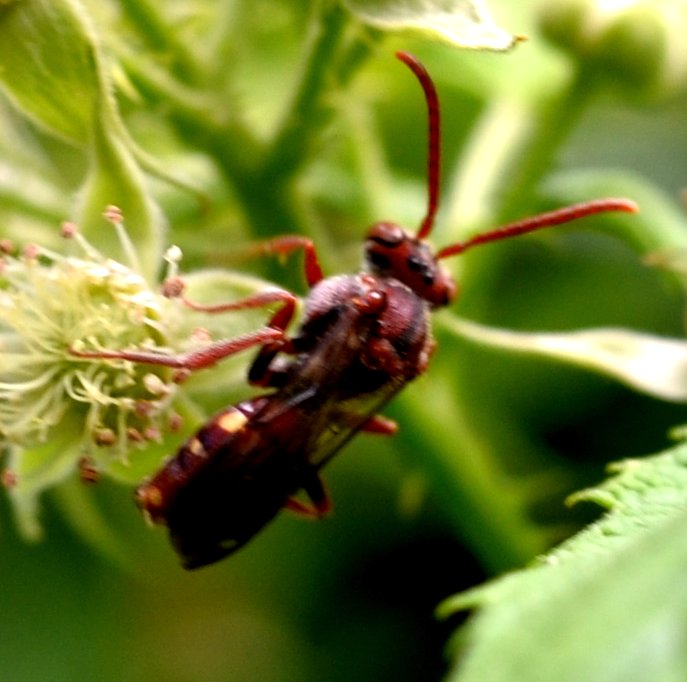
The beetles were everywhere too. This red and black one is most likely a leaf beetle of genus Oulema, near as I can tell from the pictures on the Bugguide.net search page. The beetle in the second image was found a few plants away from the first. I'm guessing they are the same mystery beetle. Last is an upside-down view of the one in the spiderwort. The spiderwort gave away the ID. Oulema longipennis on spiderwort! There seems to be a positive association between the beetle and the plant!
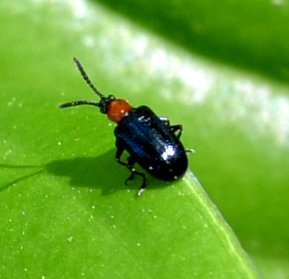

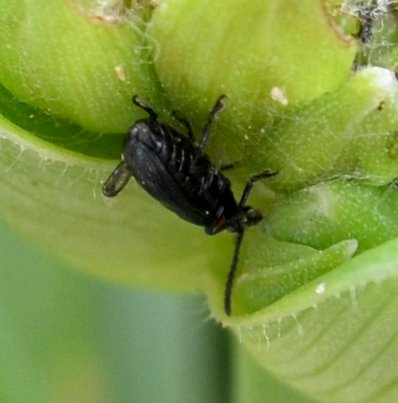
First, a largish brown beetle: first and only time seen here this year. Usually you think of carpet beetles as minor invaders of indoor areas, but this year, the goutweed (ground cover whose flowers remind one of Queen Anne's Lace) was host to a plethora of carpet beetles and several members of a large genus at that. Picture #2 is probably the coloring and pattern we usually associate with carpet beetles. Last in this lineup is a different genus, but the shape gives it away as a member of the family.
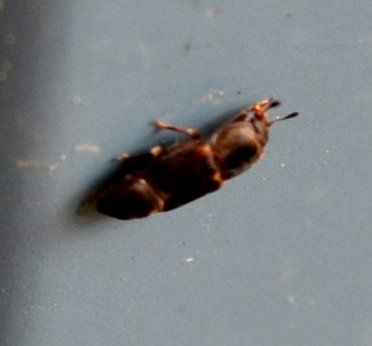

 on goutweed 6 2 17 1.jpg)
This first one looks so much like the carpet beetles. Even the scutellum (a shield over the thorax) has the right shape. Check it out! Next is a redbud bruchid. That goutweed attracts a lot of small somewhat nondescript characters. You'll see later how many pictures include a crab spider! Last is a good-sized beetle (Valgus hemipterus) that we first saw last year about now.
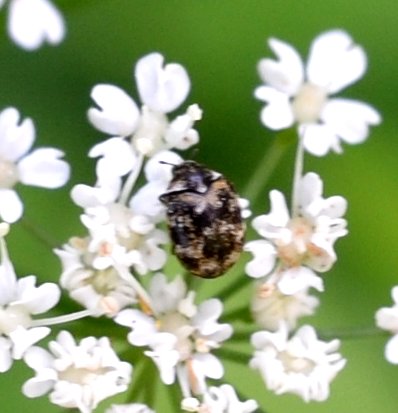
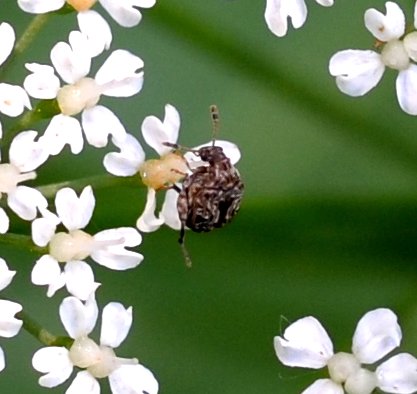
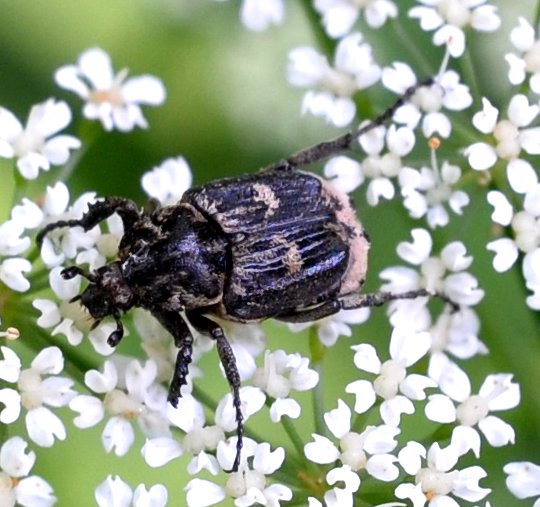
Love among the potato beetles! These monsters have chopped down my Chinese lantern plants every year since I began to try to grow the latter. Next is someone trying to avoid the camera, poor dear. And last, a tiny beetle I found inside my car.
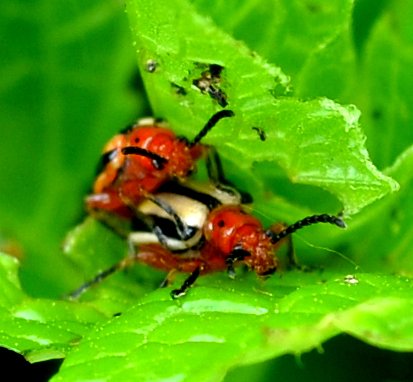

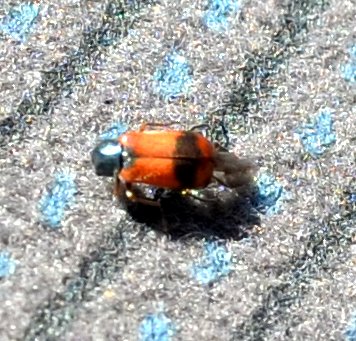
Finally, the weevils! The first one is the one I always call the "banana weevil", since when observed from above it looks a lot like a banana peel (second picture). I do believe the third fellow was featured in last week's blog, but now I've at least partially identified it as a Green Immigrant Leaf Weevil.
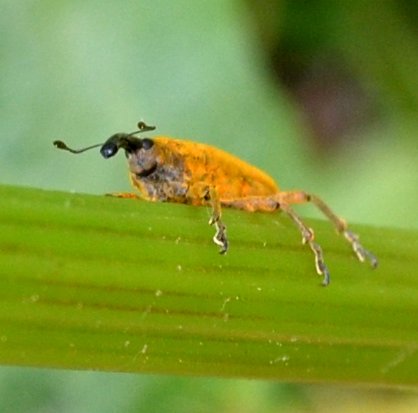
 5 30 15ab.jpg)
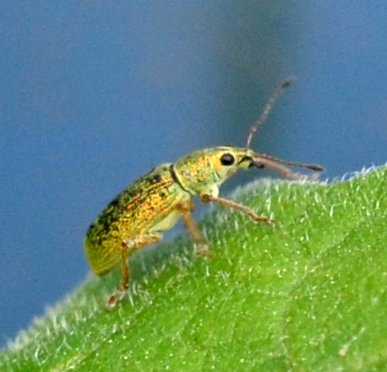
Did I say finally? I lied by at least two beetles. This first one seems to be a long-horned beetle - it is Atalantycha dentigera - but that is a Soldier Beetle. The tiny metallic one in the last picture looks more like a mirror.
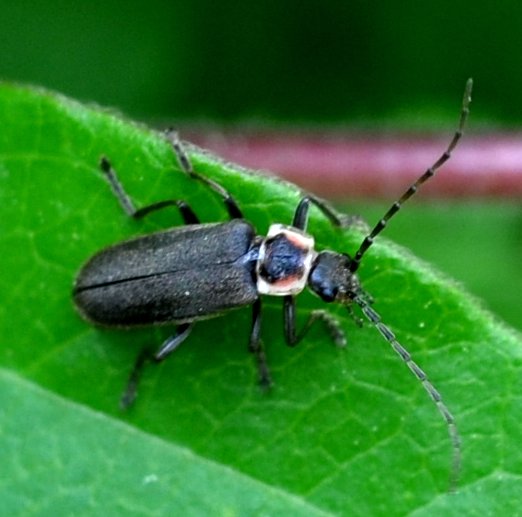
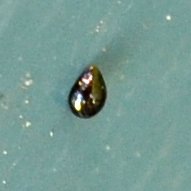
Here is at last an adult assassin bug. They don't all have the bright red knee braces, but this one must have been at just the right stage. I've no clue what the next bug is, except that it must be a nymph, since it doesn't even have wing buds. Those little Agallia four-spotted leafhoppers are back.
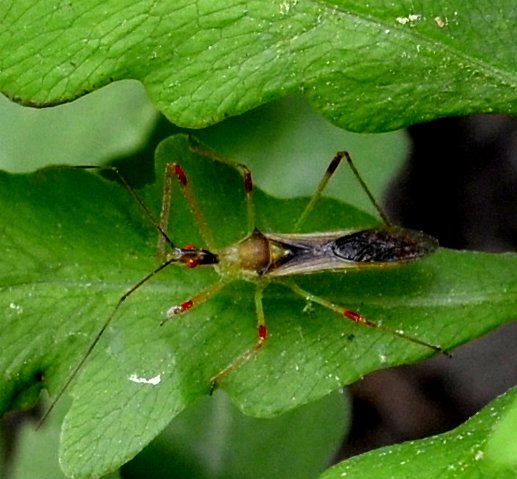
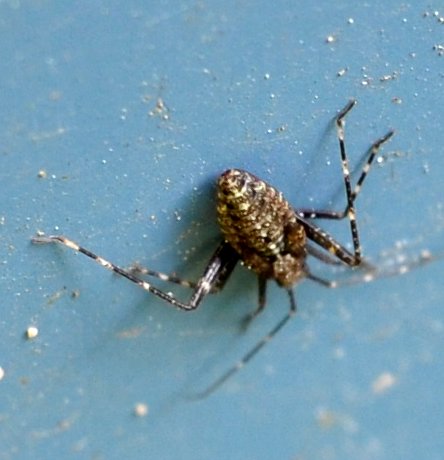
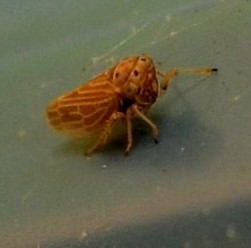
I'm not sure what this is, but most likely is some kind of orange-shaded leafhopper. Then comes a Lygus plant bug, with its nice clean pattern. Finally, a bug which to me seems to have a parquet wood floor pattern.

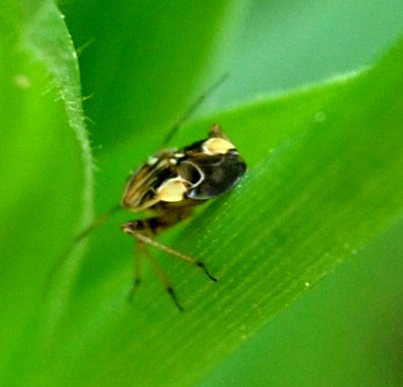
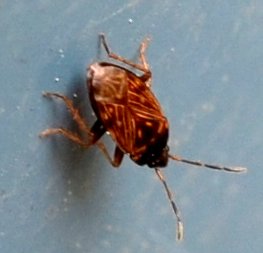
This is a seed bug, most likely Atrazonotus umbrosus. Then a stink bug of Genus Euschistus, and our old friend the white-margined burrower bug.
 5 28 17 1.jpg)

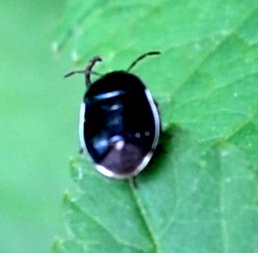
For a quick flower diversion, here is that self-started columbine in the front garden, a small clump of cranesbill geranium (a wild-type geranium, not the big pelargonium with the huge flower clusters.) Last is a tall horsetail which must have suffered some wound and is replicating the stem. (These are the holdovers from the Carboniferous Era.)
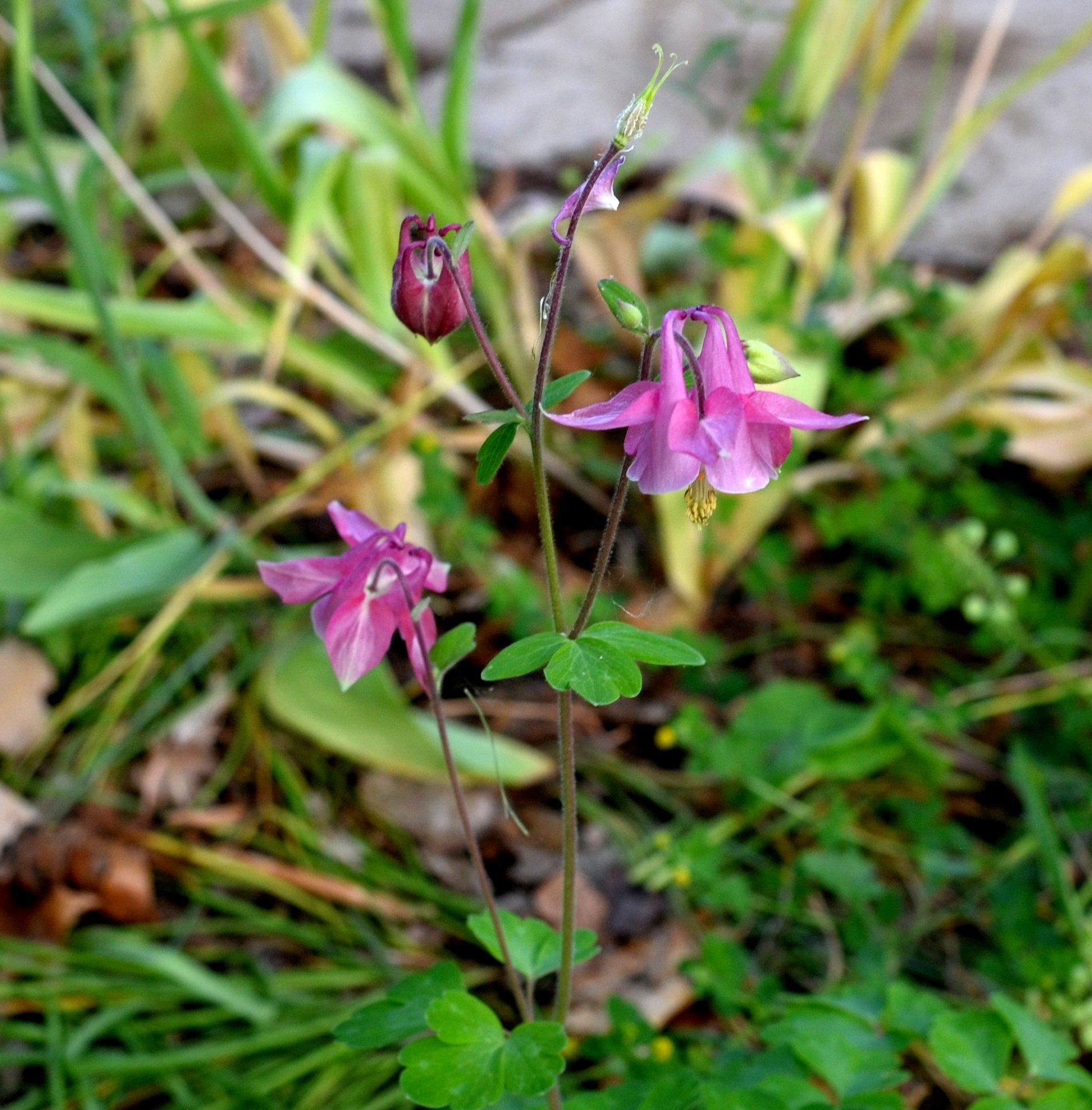
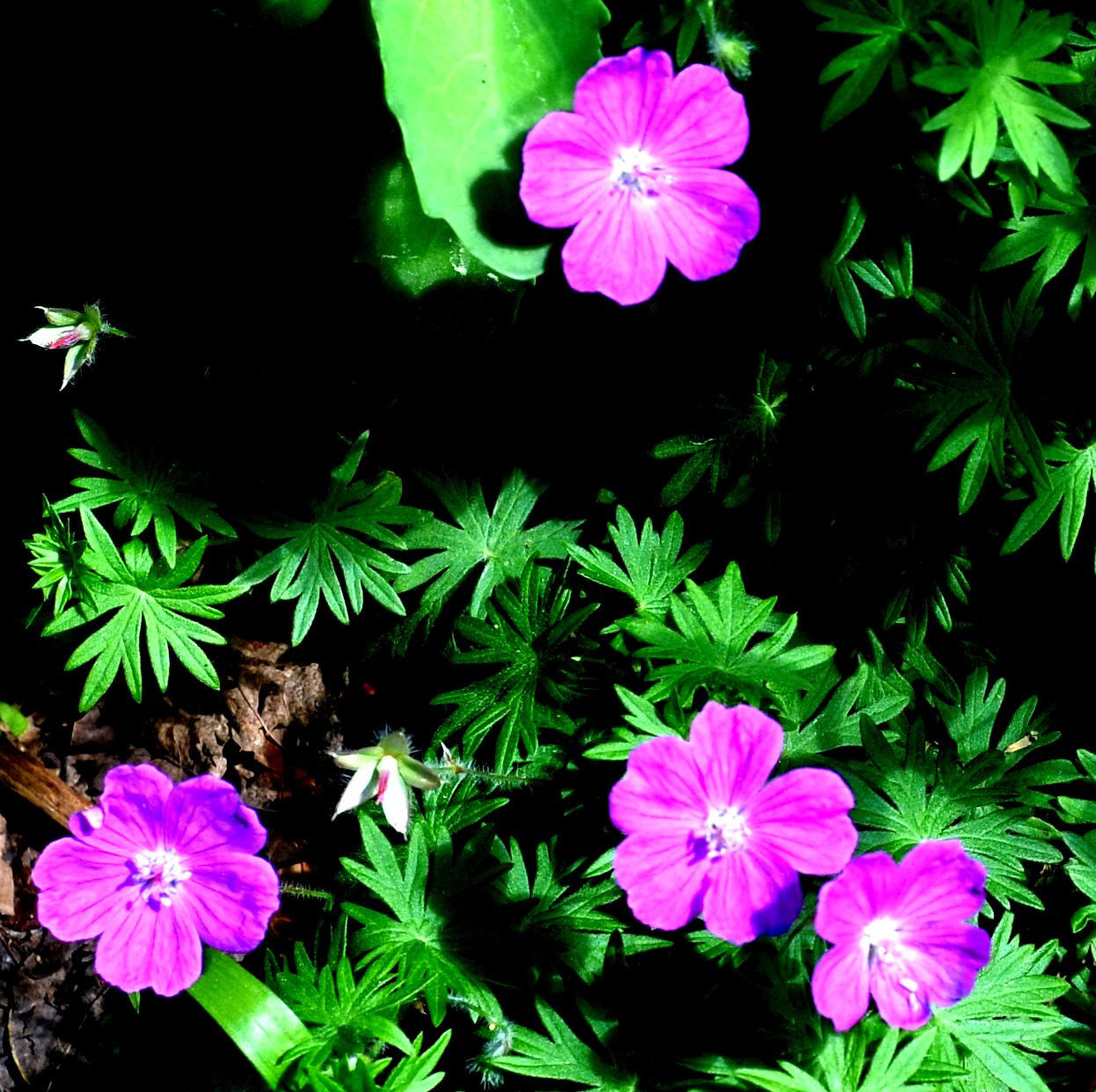
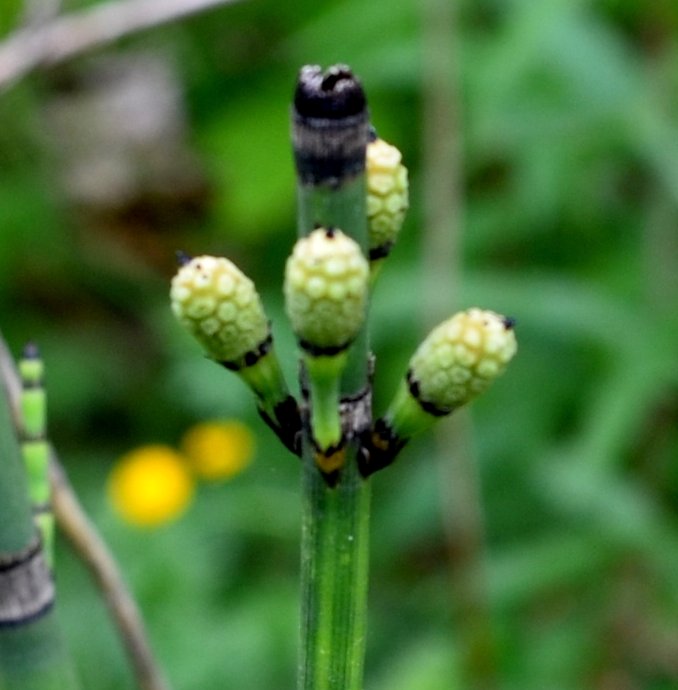
Dragonflies and damselflies were here and there, startling with their speedy flying. You have to watch carefully where they land since you lose even that flight. Here is one that Jim Whitehouse and Kathleen Seidl each sent in that I had never seen before. This is Jim's original. So far I haven't nailed down the ID under such searches as "black dragonfly with yellowish wings". The second is some sort of skimmer. At first I thought it was the female Common White-tailed Skimmer, which unlike the male is easily camouflaged. Now I'm in the bowels of searches to see for sure. This last one is the male (picture from 2014) with its bright white tail.
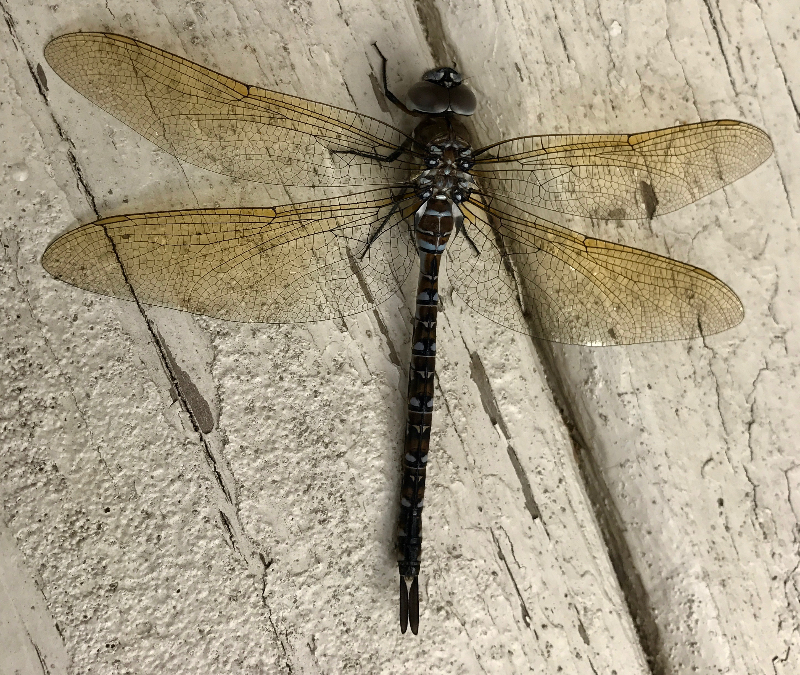
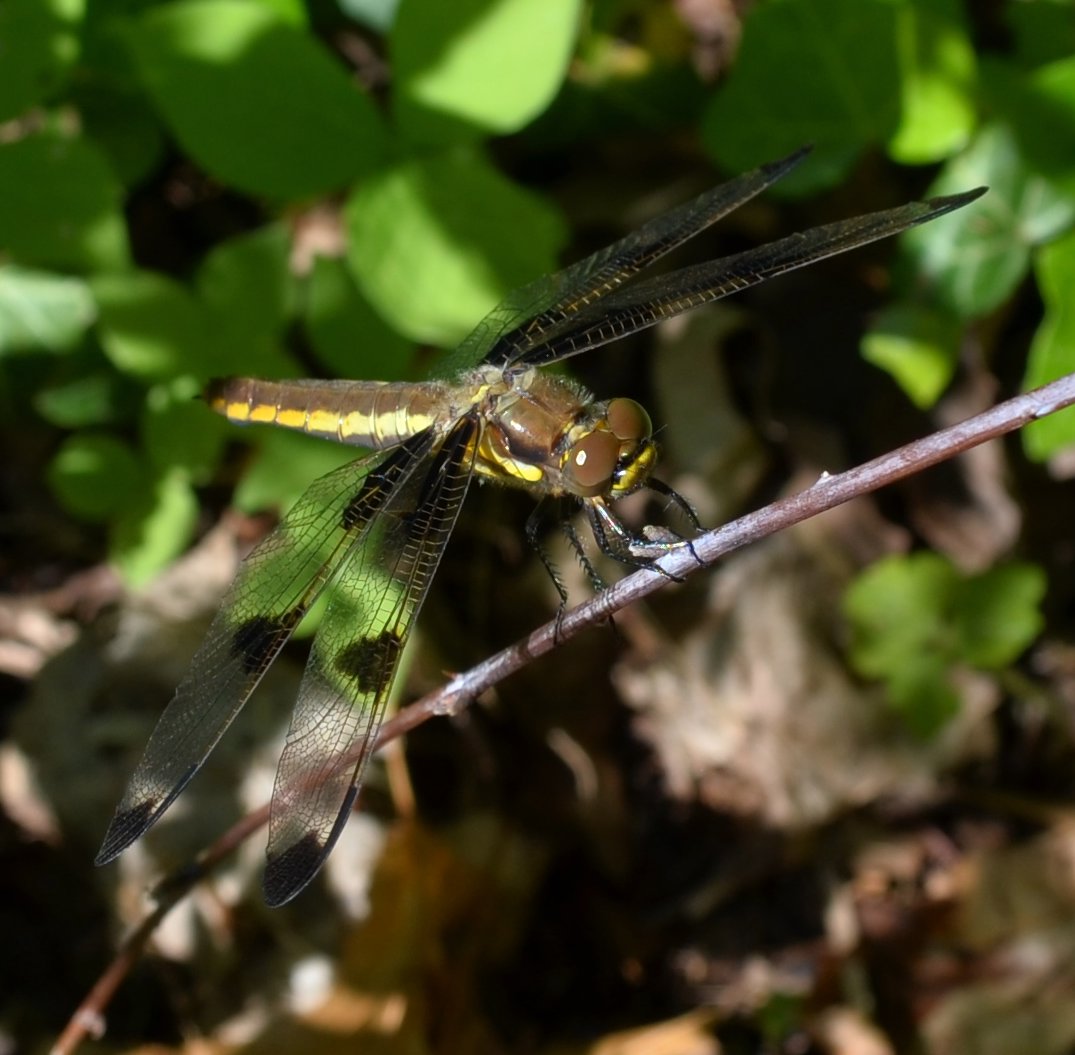
.jpg)
I spotted two damselflies. One seems to be an American bluet, like last week's version. The second seems to resemble the Eastern Forktail. Finally, a picture of most of the fishes, enjoying a swim and a snack.
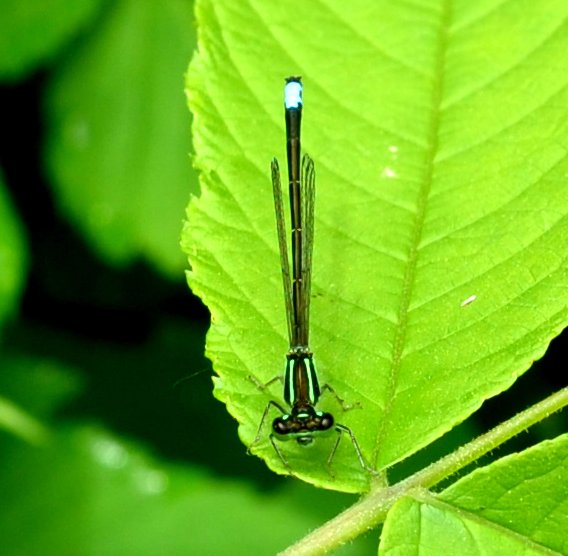
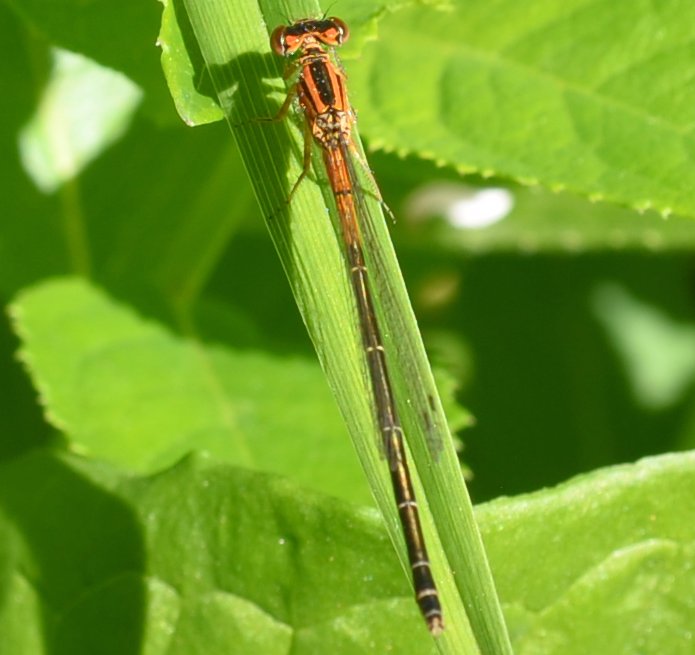
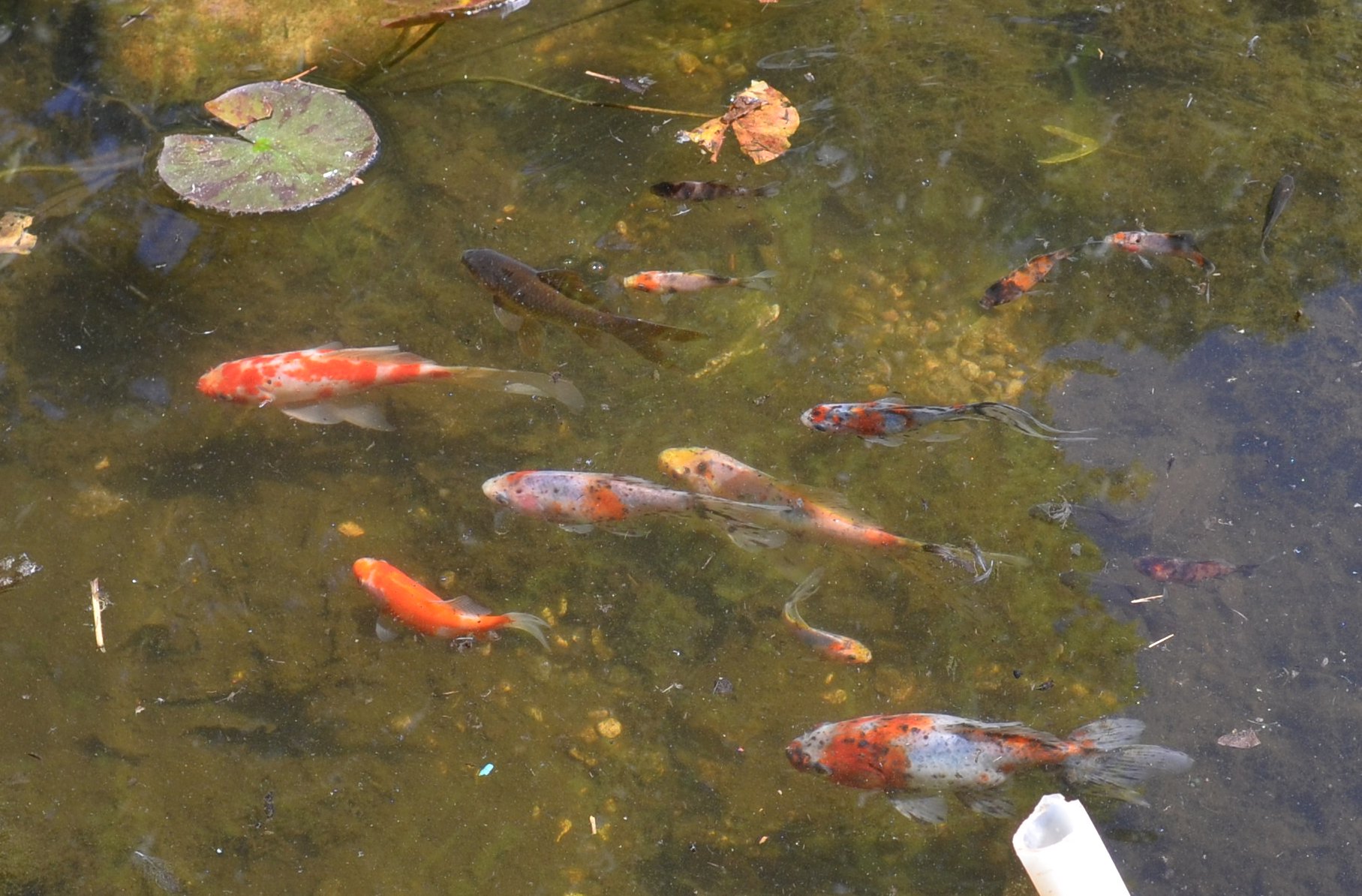
It was also a good week if you like flies, which I do. First, let's look at a good-sized family, the craneflies. This first one was out on the front porch last night. Next, that beautiful tiger crane fly. And finally, one that reminded me of a Bird of Paradise.
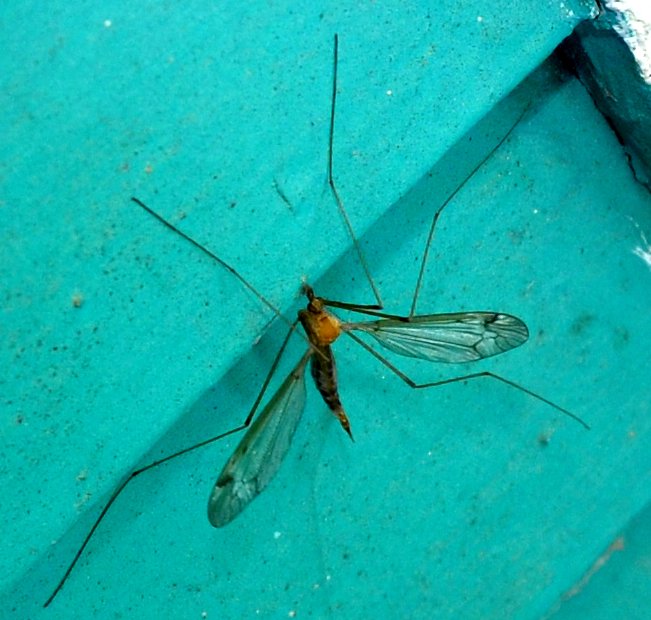
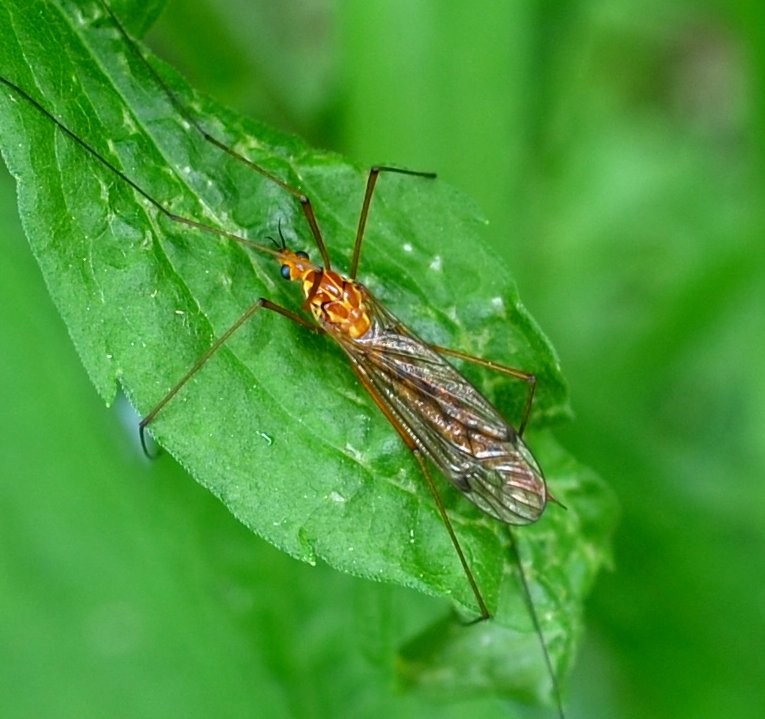
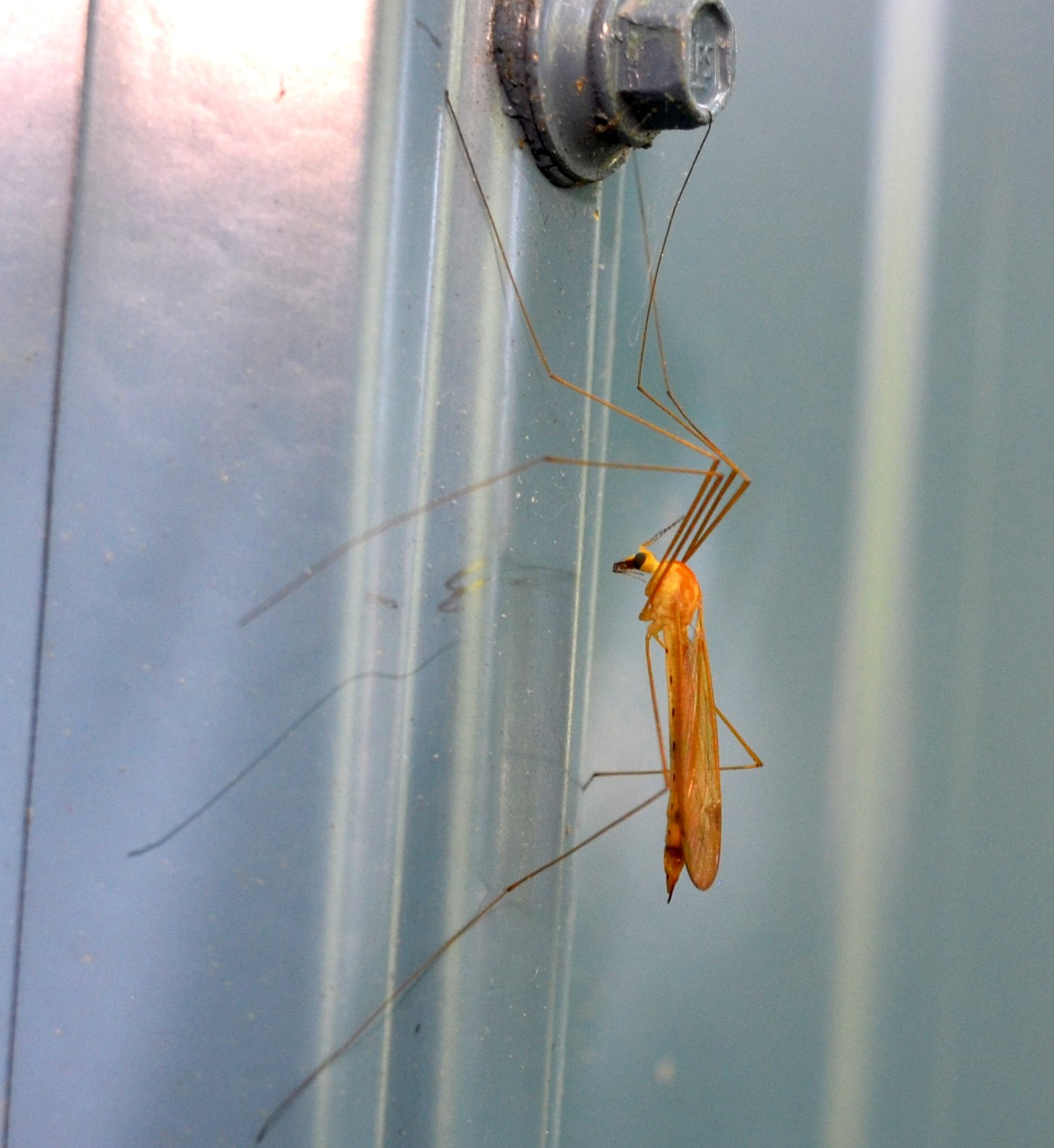
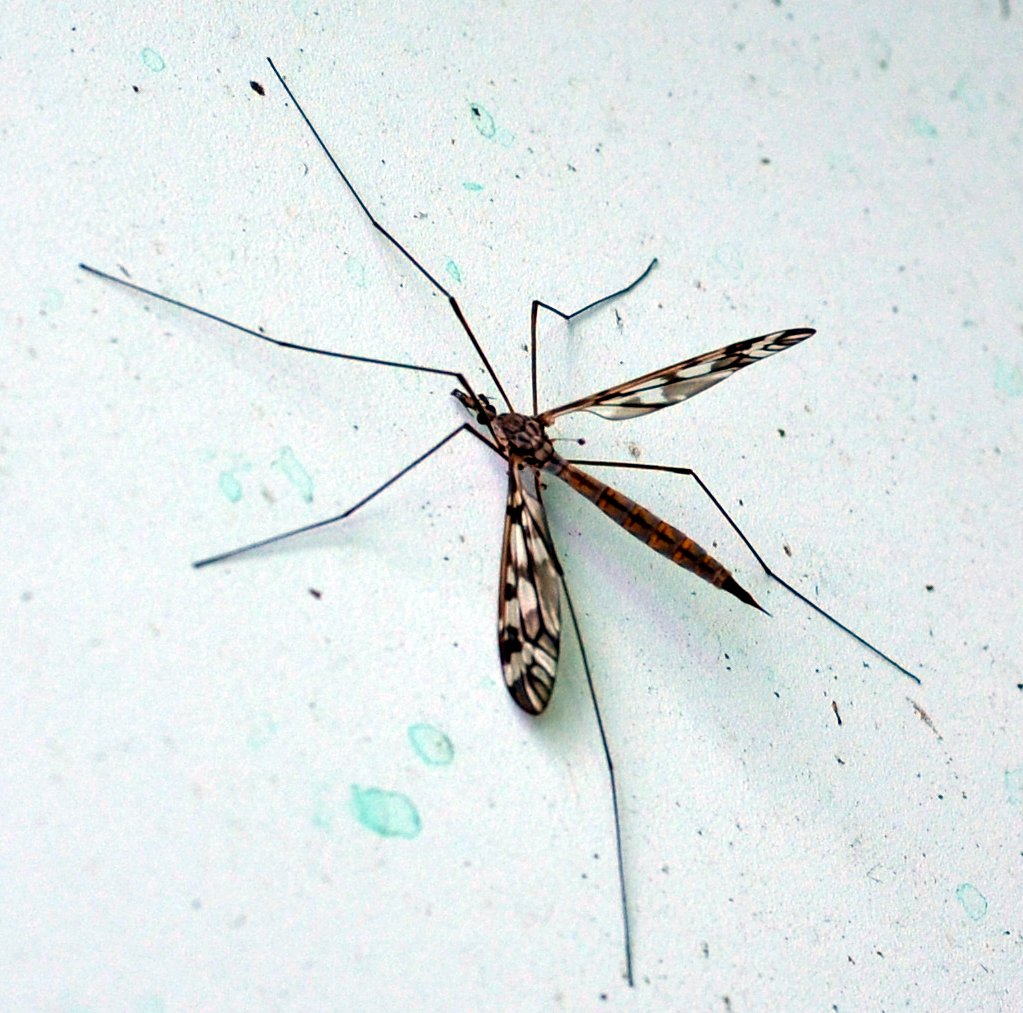
First here is a crane fly I found on the sidewalk near the Ludington building downtown. We now leave the crane flies to investigate some other pretty ones. Second is a Dance Fly, which turns out to be a predator of March Flies. The one that looks like a dung fly seems to be scavenging, maybe from the little blue balls below its leaf. I love the way they stand up like that, seeming to be looking far away.
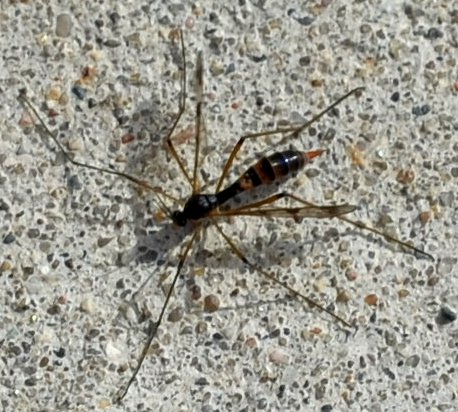
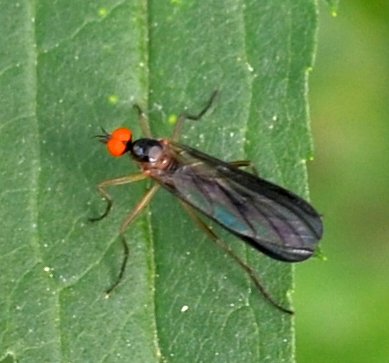
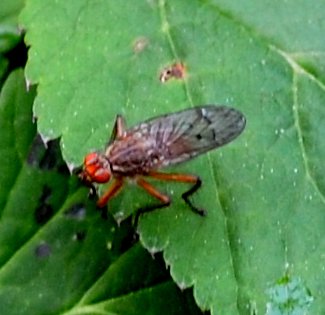
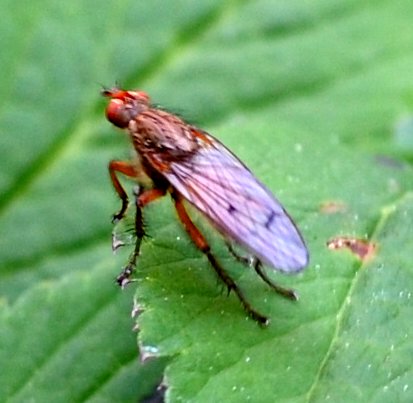
A very bright-colored little fly showed up and stayed around long enough for me to photograph him a few times. I say "him" because he resembles the little male gall midge of a month or so back.
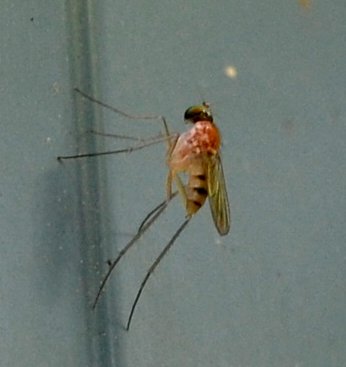
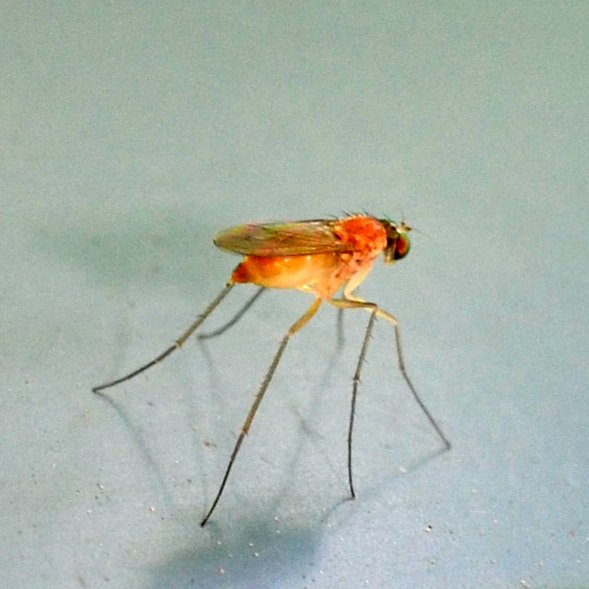
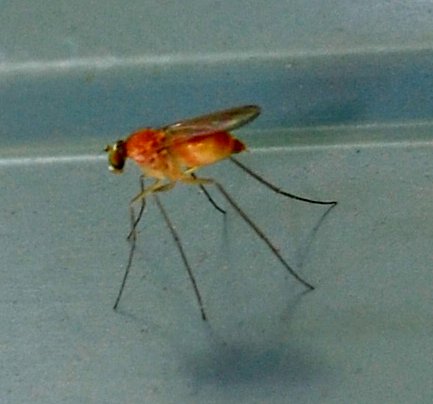
Here are the only hoverflies I saw this week. The first one may or may not be a hover fly, but it has the right size and shape. If someone finds out what it really is, I'll credit you with the information!

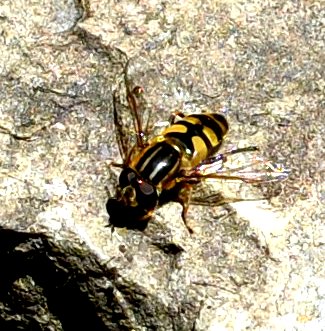
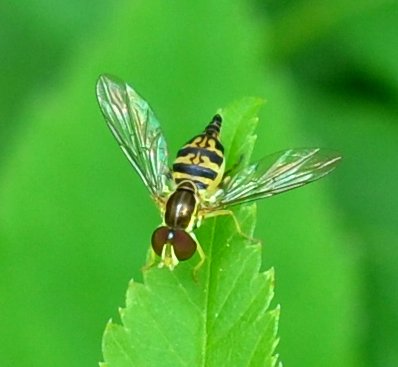
Here's an interesting trick. This ordinary fly turns all silver when it lands on a silver-colored car. It isn't, of course. I've never noticed so many Lance flies around, but there they are. Picture #3 was taken in the afternoon. Look at the shadow this long-legged fly makes.
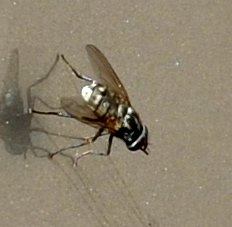
 5 28 17 1.jpg)
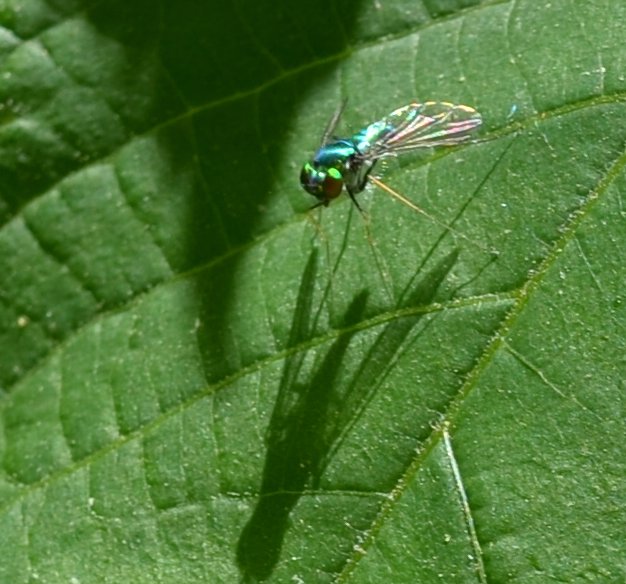
This mystery mosquito was catching the alpenglow when I came upon her. And here are two moth colors - both flies! I've also seen a white-colored one. I don't know if they count as separate species or different dye lots.
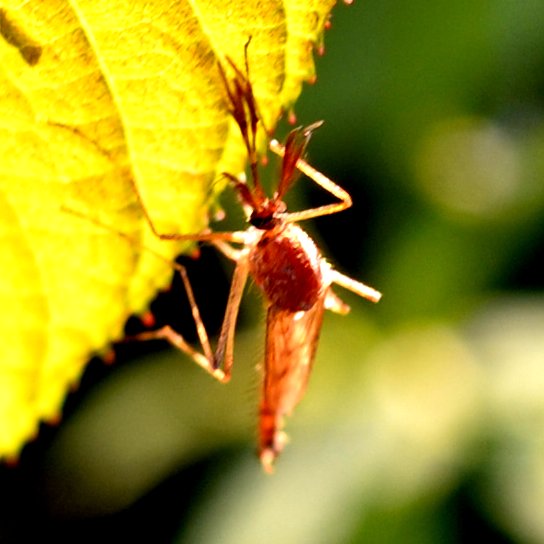

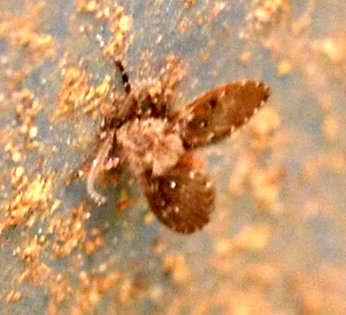
Here's yet another fly that seems to appear over and over on the family tree. The second one I thought might be among those gall midges, but the time signatures are a couple of days apart.
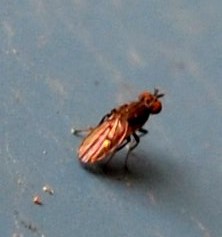
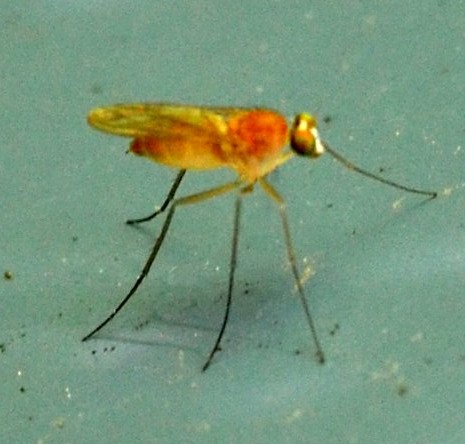
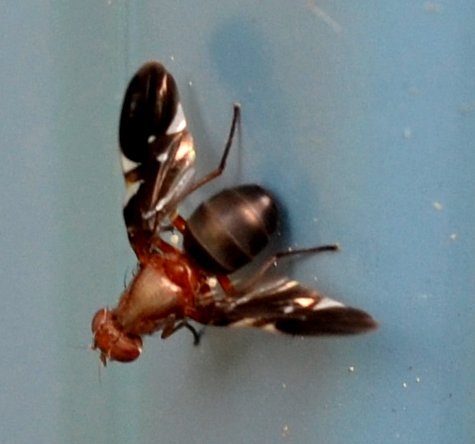
The first fly is a blue blow fly. The second is a pure-black version of one of the popular body models. And third is a scavenger fly. It has stilt legs and an elongated body. Last year we had lots of these little flies, and a whole lot of mating going on. Actually it may have been about this time in 2015. You check and I'll check.

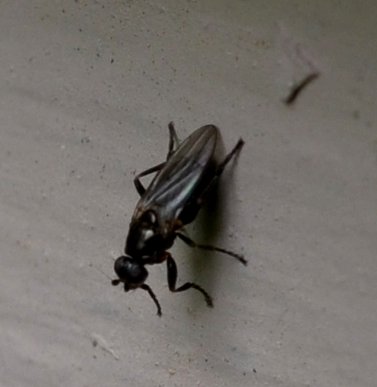
 5 30 17 2.jpg)
Let's see. After last week's surprise visit from the Giant Ichneumon Wasp, I was sort of expecting more Ichneumon wasps or Braconid Wasps. Here we are on May 28, one ichneumon wasp. After that, Ichneumons kept themselves a bit scarce. I was happy when the goutweed started to bloom. Its tiny flowers are good protection for insects about that tiny, and one of the happy hiders was this so-called gasteruption, or carrot wasp. This is the male. It turns out that today, just after the closing time for pictures for this week, I spied the female with a little ovipositor but you will have to wait till next week. In the meantime, here is the gasterejection that I found in June 2015 in the same goutweed, and a female. This one is probably a different species from this year's lot, based on the length of ovipositor. Note that the carrot wasp is NOT a wasp. It follows a different path down the family tree, through Parasitica, to get to its place. It's best to call it hymenoptera, as in this last picture.
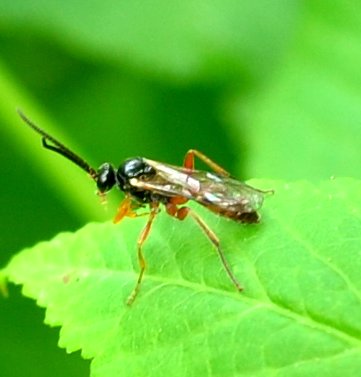
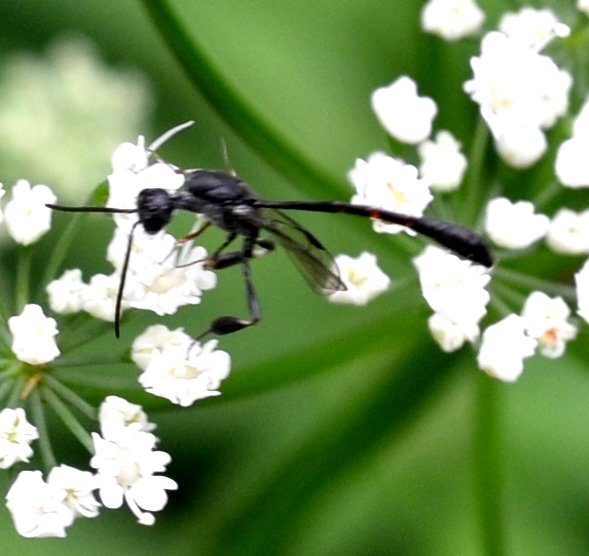
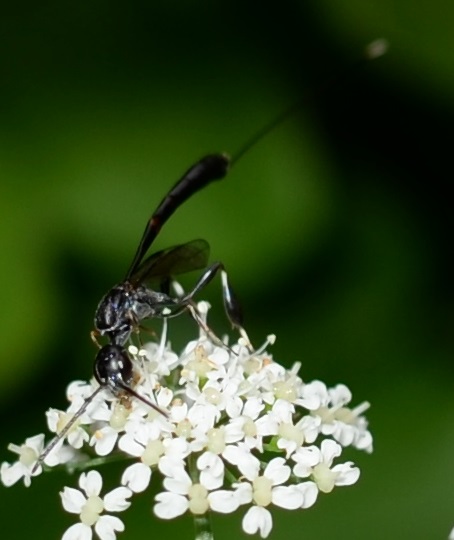
Now to your favorite, you know who you are, your favorites the spiders. We had many many kinds and shapes of spiders. Here is one of the little round ones, hiding under an aster leaf. Then comes this black spider - could it be a later stage of those tiny little black spiders? Or possibly a young Grass Spider? Finally, a baby common house spider turning out to be a little male. No more black and white spotted legs!
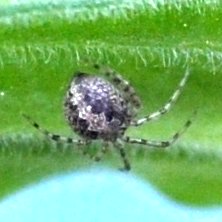

.jpg)
First up, here's a northern crab spider in the goutweed. The other afternoon, a large percentage of the goutweed clusters contained this very kind of spider! So you can see how vicious such a tiny spider can be, look at picture #2. Don't notice this, but it appears to have grabbed its victim by the face. Don't think about it. Third, this ground crab spider seems to have been printed with lovely paisleys.
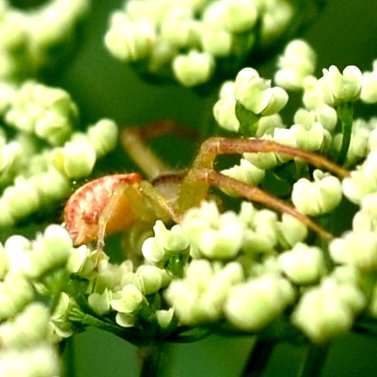
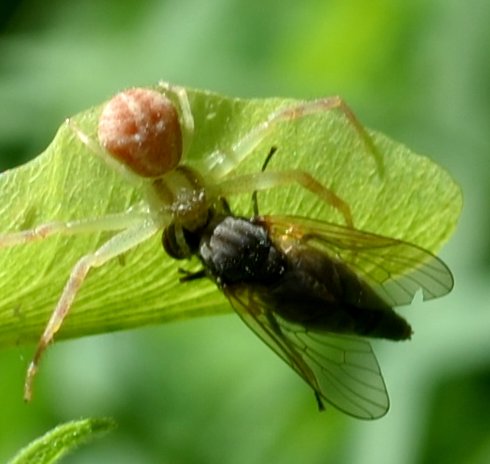
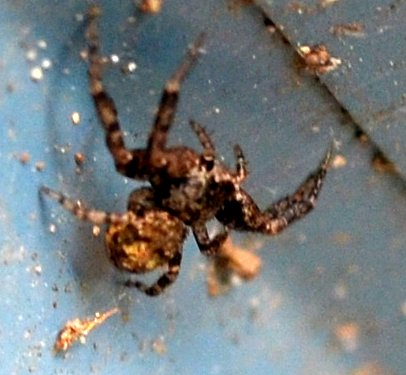
This very large ground crab spider was walking on an upper leaf of a plant. Almost the same time, this new kind of spider emerged too, unless it is a different angle from the first. The third one seems to be stalking a goutweed cluster which is still not blossomed white.
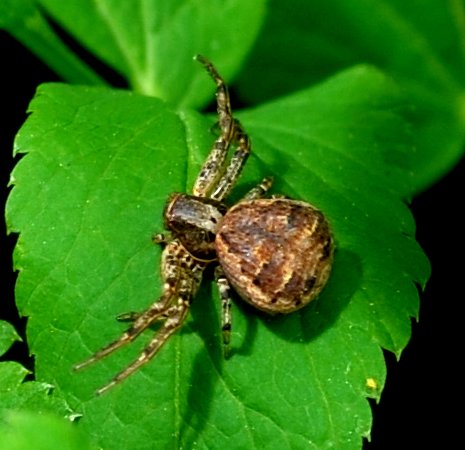
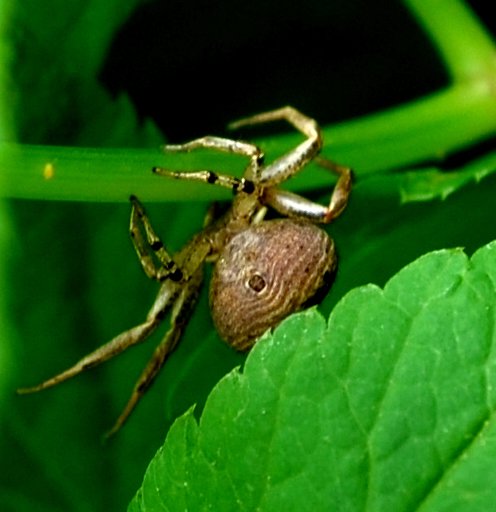
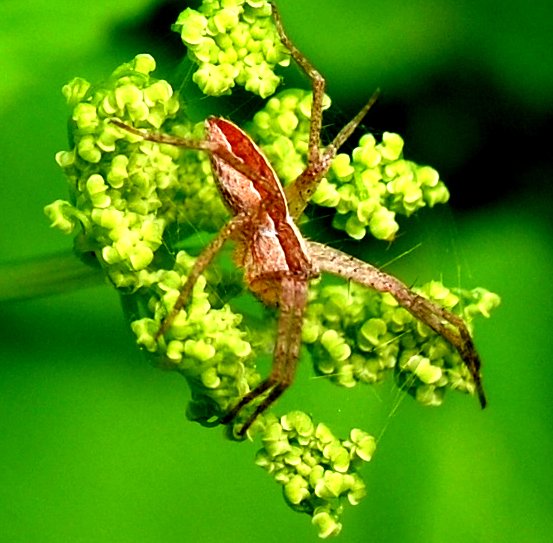
On that same walk, a number of jumping spiders came out to play. The third one is so beautifully patterned I thought at first it was Naphrys pulex, but now it seems more ornate.

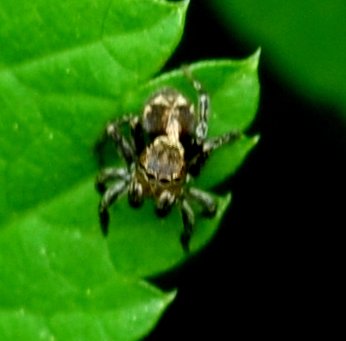
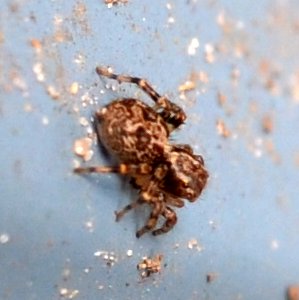
Under what seem like goldenrod leaves was lurking this large spider. This next one I thought at first was a running crab spider, and I'm not convinced not yet. Parse this! Meanwhile, one of the baby spiders I suspected was going to grow up into a pirate spider, in particular, Mimetus puritanus, has done so.. Check out the two white "eyes".
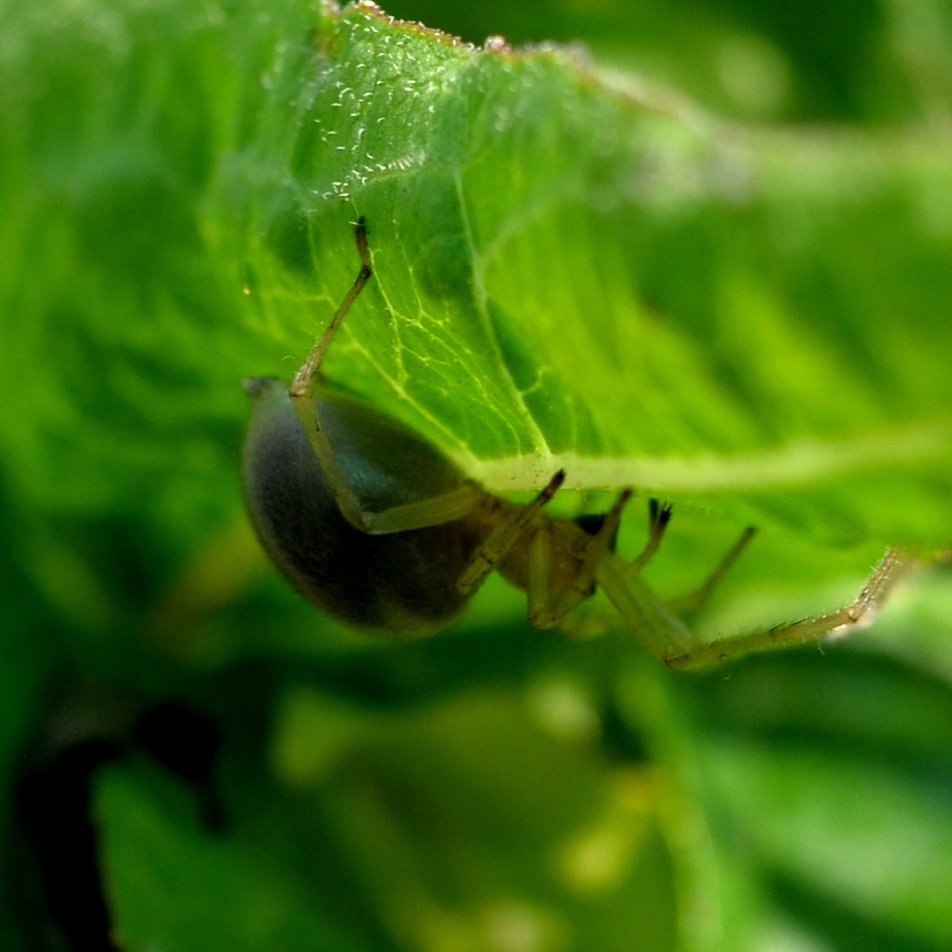
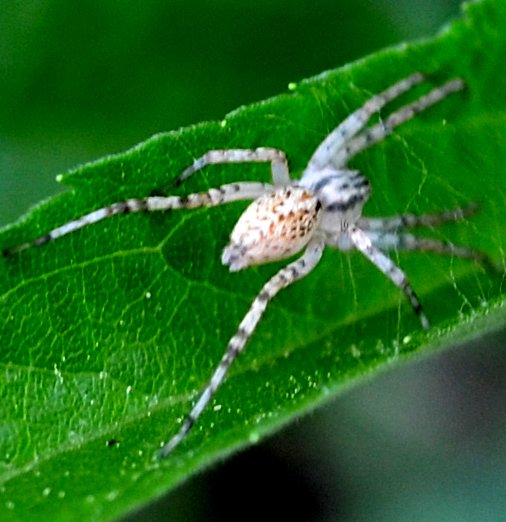

Now are you ready for a real treat? Do you remember the beautiful green long-jawed spider that has appeared both winters in two years, but never in the summer. Knowing that it was going to spend its adult life in my blue spruce, which sheds leaves and cones into the yard just near the shop eased the shock when I finally found this one on the shop siding. This last one is colored in a way I never saw before. Very odd, but hey, very welcome to the yard in the summer!
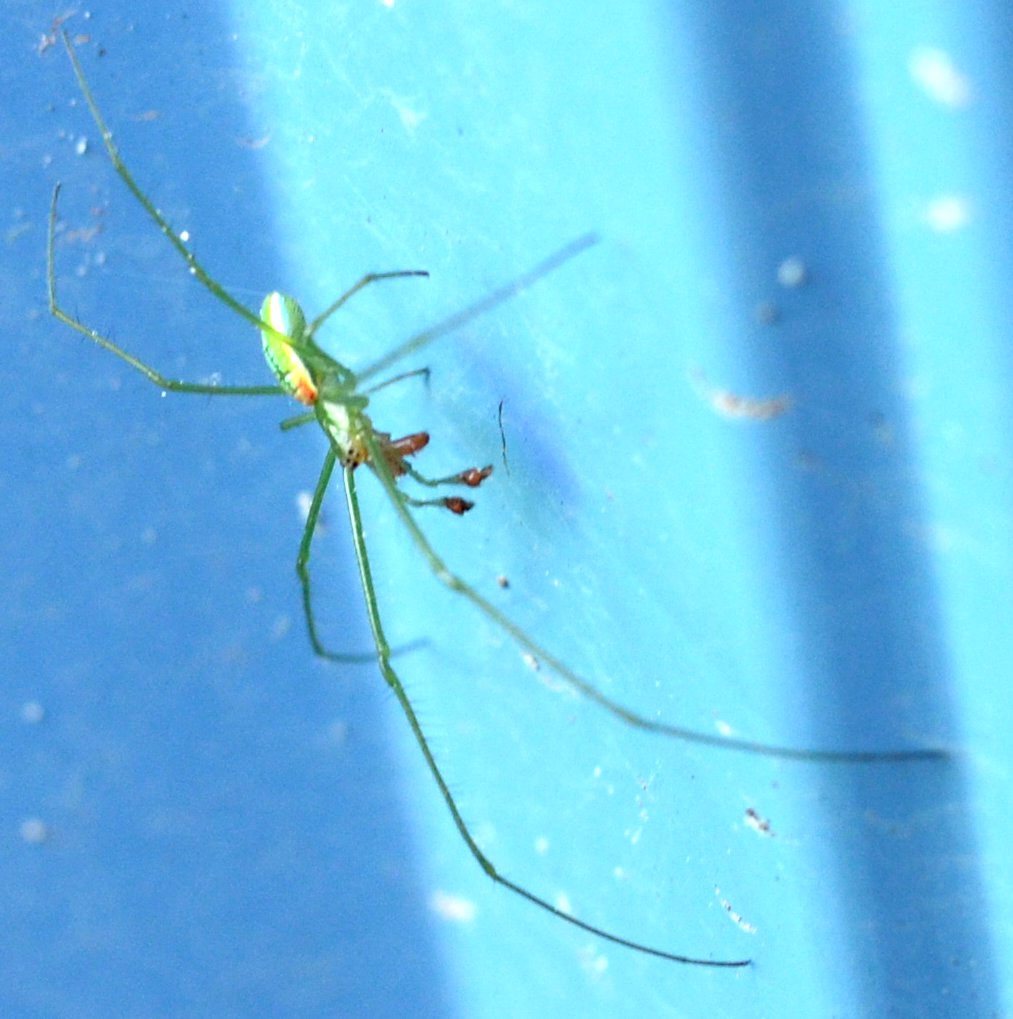
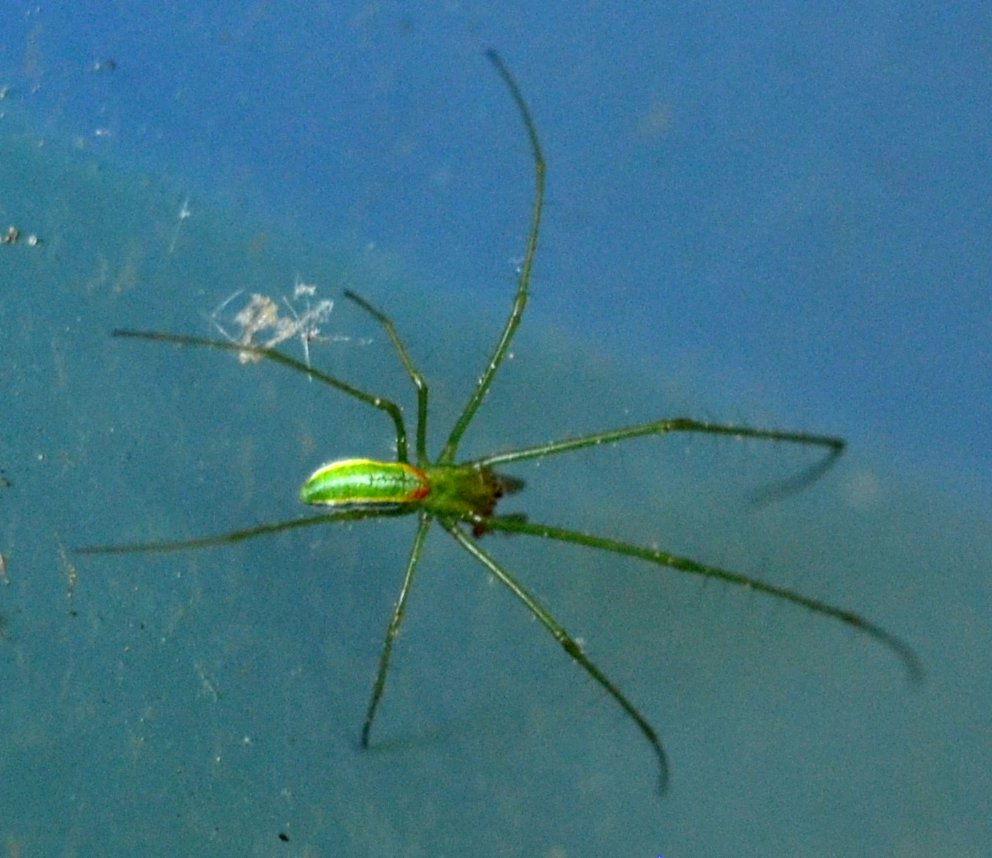
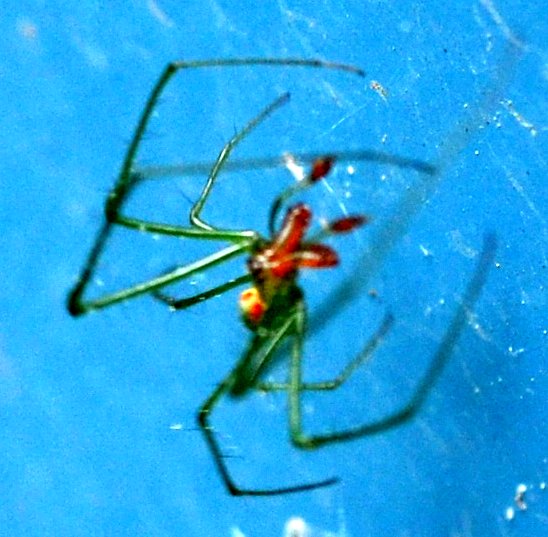
Oh, how could I almost forget the wasps? They are starting to come to visit, but the first two of these wasps were found in the flowers just outside of Bobbitt Auditorium. This one is genus Polistes, but I can't make out the species. But since we can count the segments of the abdomen in picture two - six segments, thus a female (males have seven), and the female of the species is much more variable than the male, this might very well be a female Polistes fuscatus, our beloved Northern Paper Wasp. In fact, we did have a female Polistes fuscatus in the raspberry blossoms at home.
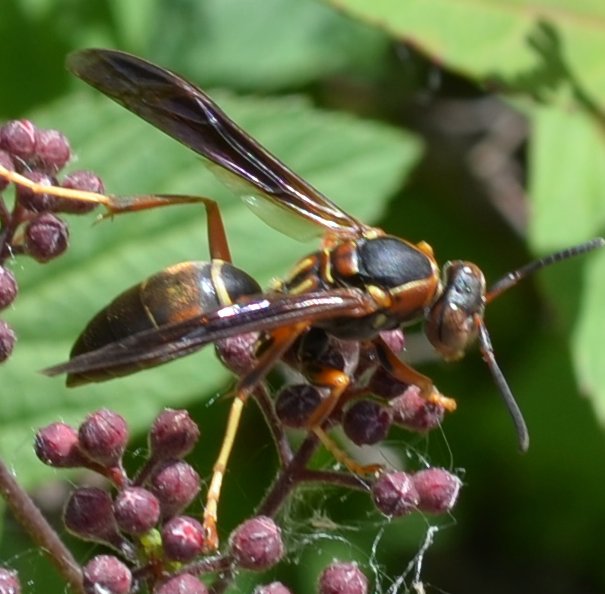
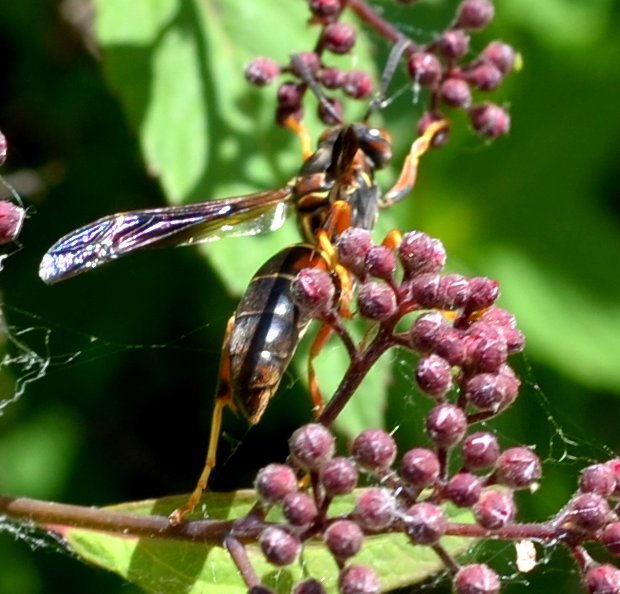
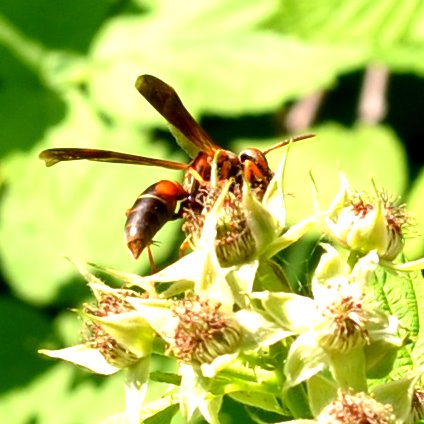
At home, we had a visit a few times from one of the yellow and black wasps. I have got to go to my old pictures from last summer, when I could actually recognize a few species, and try to ID this one. Counting abdominal segments tells us it's a male. I'm going down through the Buck book starting with Ancistrocerus genus. The face, seen in picture 3, matches with Ancistrocerus catskill, male. And the rest of the markings also match. So this is one of the little potter wasps, the ones that make the cute little clay pots to raise their kids in.
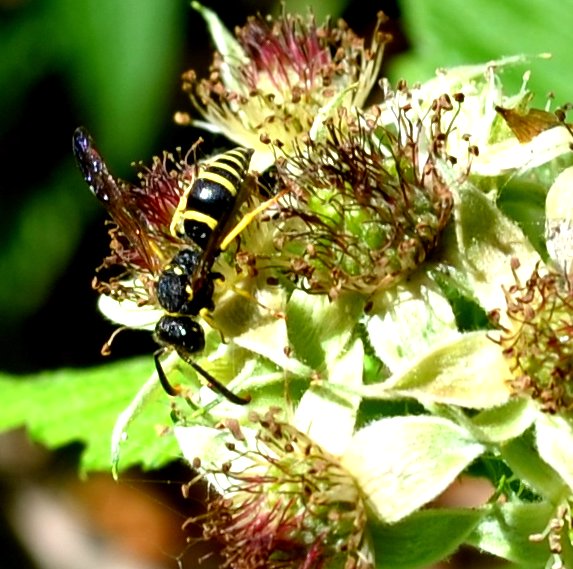
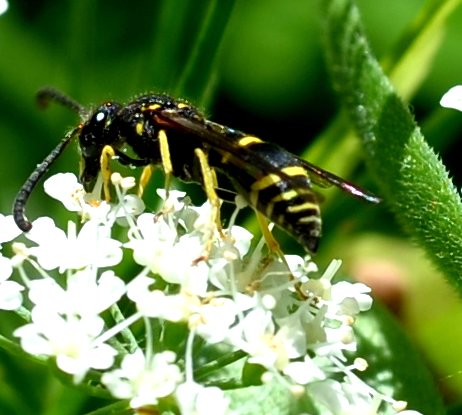
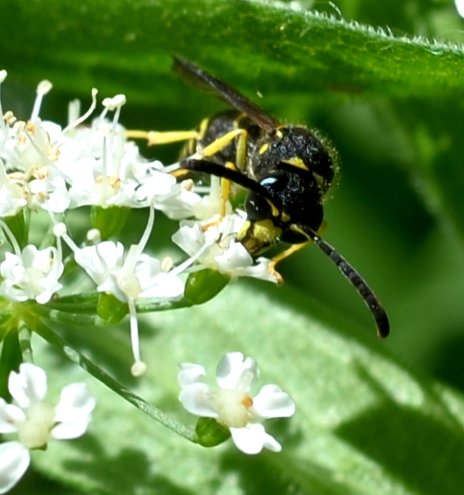
So that is it for this week. I'm feeling a lot better, and back to spending most of my up time taking pictures. I hope everyone within writing distance is doing very well and learning a new trick a day.
Love, Martha
Back to May 28, 2017
Forward to June 11, 2017
Back to 2017 menu

















 on goutweed 6 2 17 1.jpg)







 5 30 15ab.jpg)









 5 28 17 1.jpg)







.jpg)


















 5 28 17 1.jpg)









 5 30 17 2.jpg)





.jpg)




















